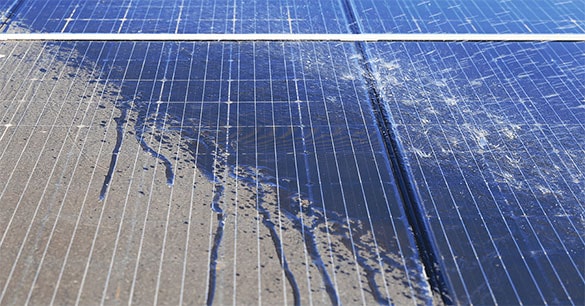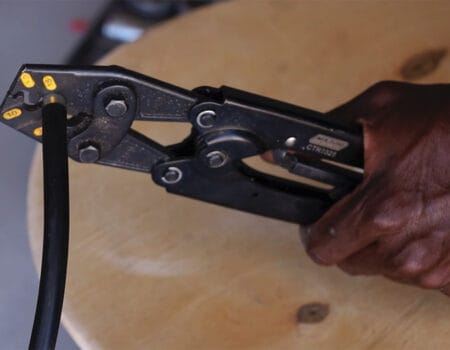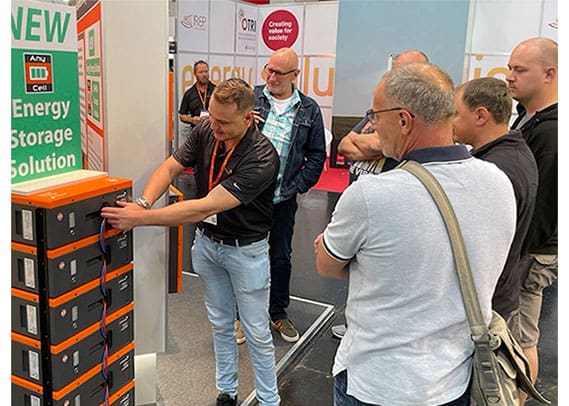
Question: If solar is ‘maintenance free’, do I need to clean my solar panels?
‘Maintenance free’ is the right way to describe a photovoltaic system. Typically, there are no moving parts, so if designed and installed properly, the system will run smoothly for many years. Proven for decades, this has been a key feature of a photovoltaic system, many around the world have trusted and benefited from. This point is not in question. However, as the solar industry and solar professionals have gotten more sophisticated in recent years, many seek out opportunities to maximize solar system production and performance.
To start, it is important to understand how soiling works. Dust and dirt settle on the surface of a solar panel, and over time, a layer can form that may have a slight impact on solar production. The amount of impact can vary. Typically installers will position the solar panels so that even on a flat roof there is a slight tilt to help the rain offer natural PV panel cleaning. Ideally, the water washes away the dirt and once the rain is over, the panel is clean with nothing left over to worry about. However, if the water doesn’t completely clear off the dirt and it pools a dusty layer at the bottom of the panel’s frame, now the dirt pool is something to be aware of. If the dirt pool is high enough to go beyond the frame and open space area, starting to cover the lowest row of cells, it will impact solar production. If an inch is covered on the lowest row of cells, one might look at their entire solar panel and think there is nothing to worry about. It is natural to assume that a small amount of solar cell coverage shouldn’t make a difference. However, it is important to understand if 10% of a solar cell is covered that doesn’t equate to 10% of one cell’s production being lost. It isn’t a 1:1 ratio because of how electrical current flows in each solar cell, and from cell to cell. To be clear, every cell in a string of cells, will operate at the current set by the cell that isn’t producing optimally. This sacrifices production of cells not impacted by the dirt. Without getting too technical, the goal is to not have dirt covering any portion of a solar panel’s solar cells, for long periods of time.
The solar industry has many differing opinions on the topic of cleaning solar modules. Sometimes it matters what company one works for, and if someone is a traditionalist or likes to move with the times. Here are key factors to consider:
- Climate and weather conditions can be different in neighboring cities or nearby neighborhoods. There isn’t a one size fits all answer. If you live next door to a farmer growing grain crops, you may get more dust landing on your solar panels than a family member’s solar panels living 2 miles away. Maybe you are prone to this farmer’s excess dust creation and you live in a drought ridden community, or you live in a region that enjoys a long rainy season. It is really a consideration one should keep in mind, knowing their conditions.
- There are products on the market to measure the degree of soiling on a solar panel. This type of monitoring may or may not be of interest, depending on the critical nature of the applications and potentially the size of the solar array.
- Beyond normal dust and dirt, solar panels in certain locations by airports and major highways, for example, gather smog or oil-based pollution that can resist normal, natural cleaning by rainfall.
- The amount of solar panels a customer has could range from less than 1kW to over 1MW. The amount of potential solar panel production could also be a factor to consider how aggressively to address the topic of proactive cleaning versus allowing natural rainfall to clean the solar panel glass. It is all relative to the system owner, but capturing every Watt possible on a daily basis, to maximize the solar system investment is a goal everyone has when investing in a solar solution.
- using estimated 10% lower production (due to heavy soiling) in a 1kW system = 100 Watts lost per production hour
- using estimated 10% lower production (due to heavy soiling) in a 1MW system = 100 kilowatts lost per production hour
- Companies offering solar panel cleaning services have differing opinions about how to clean the solar panels to get the best results today and long term. If you are considering a module cleaning service, discuss processes and why these companies use this protocol (type of water, type of tool to move on the glass surface, manual or automatic, etc.). Get educated before taking action.
- Review your solar panel warranty and understand the manufacturer’s recommendations. Do not take any action that would impact the warranty.
- If choosing a DIY approach, it is very important to never put water on solar modules when it is warm outside or when the panels are warm to the touch.
In the end, one can rely on rainwater for self-cleaning or take action to be more proactive to avoid potential degradation of productivity of a solar array. It comes down to the critical nature of the application, the conditions local to the solar array, bandwidth, economics, and potentially the size of the array, to engage further. For many residential installations, the old saying “if it is not broken, don’t fix it” could be the simple advice to follow, as far as proactive cleaning goes. The consumer should weigh the passive and active cleaning approach and define what is best for their situation.












